Tokyo Tech finished third and Tokyo Tech High School of Science and Technology finished second at Japan and the Sea: Underwater Robot Convention in JAMSTEC 2019, a competition for underwater robots held at the facilities of the Japan Agency for Marine-Earth Science and Technology (JAMSTEC) from August 23 to 25.
This year, the competition consisted of three divisions: the Freestyle Division, the AI Challenge Division, and the Junior Division.
Freestyle Division
As its name suggests, this division focuses on original ideas and technologies utilized in underwater robots. Teams create their own robots from scratch and are awarded points based on presentation, weight, and competitiveness. This year, ten teams participated.
Team gen, made up of members of the Aqua Lab from the Society for the Study of Robotics, an official Tokyo Tech student club, finished third in this division with their robot gen4.
Team 18 from the from Aqua Lab also participated with their robot Water gun Taro, as did a Tokyo Tech High School of Science and Technology team with their robot Drepana Unit 1.
AI Challenge Division
In this division, teams develop algorithms and compete based on processing ability. These algorithms are applied to autonomously controlled robots that attempt to burst underwater balloons spread around the course. Team can use either original robots or ones provided in advance by the organizers. Points are awarded for course performance and presentation. This year, seven teams participated, including one from the Aqua Lab with their robot Mark3.
Junior Division
This division is for middle school students, high school students, and technical school students only. Teams are provided with a robot kit that they must assemble and remodel as they see fit. Robots then compete by collecting cans submerged in water within a time limit. This year, 12 teams participated
Team Piyopiyo Soul from Tokyo Tech High School of Science and Technology finished second in this division.
Team gen, Aqua Lab, Society for the Study of Robotics, Tokyo Tech
Third place in Freestyle Division
- Takeshi Moriya, 3rd year, Mechanical Engineering
- Hayato minamoto, 3rd year, Mechanical Engineering
- Takamaru Saito, 3rd year, Mechanical Engineering
- Yusuke Mizukami, 1st year, School of Science
Comments from team leader Takamaru Saito
Our robot was originally developed as an autonomous underwater vehicle that can withstand long distances and long use periods stably. We tried to keep the body slim to reduce resistance in water. When a robot arrives at its destination, its operators need to be able to insert a variety of components. Therefore, we created a mechanism that allows the automatic opening and closing of the top cover. We also created an automatic draining mechanism.
Waterproofing is obviously an important technology in underwater robots, as elements such as the battery, motor, and electric circuits must be protected. Shielding the component that transmits power from the motor to the propellers is particularly challenging, as the rotating shaft straddles both parts that require waterproofing, and parts that do not. To solve this, we applied magnetic coupling to avoid physical mechanical connection.
Our robot was fully tweaked on the day of the contest, and our pilots operated the mechanisms with outstanding timing. The shapes of the fuselage and screw were designed based on knowledge we had gained at Tokyo Tech. Overall, it was an excellent experience, as we were able to apply what we had learned during our lectures. I am very pleased that our robot was so highly evaluated.
In the future, we aim to develop robots that can work underwater, for example with the use of a robot arm, and underwater robots that can accomplish tasks through autonomous control.
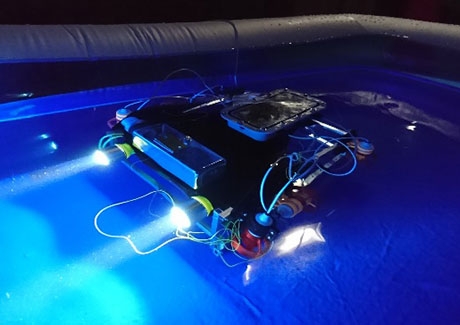
Mark3 competed in AI Challenge Division
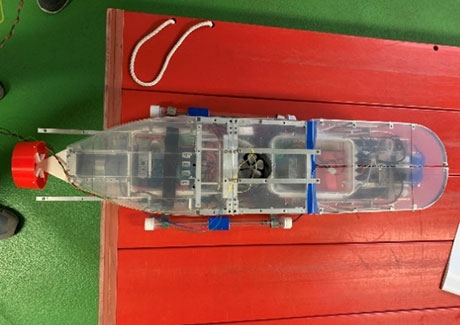
gen4 placed 3rd in Freestyle Division
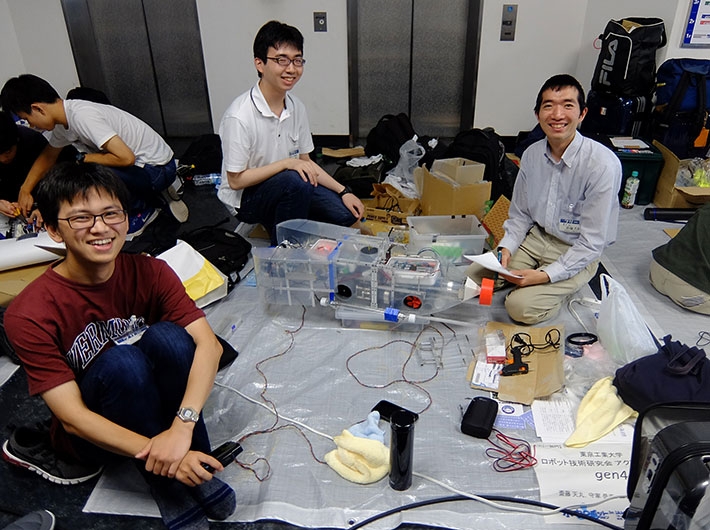
Team gen members during maintenance break
Team Piyopiyo Soul, Tokyo Tech High School of Science and Technology
Runners-up in Junior Division
- Ryoya Sato, 1st year, Department of Science and Technology
- Kokoro Ikeda, 1st year, Department of Science and Technology
- Midori Okabe, 1st year, Department of Science and Technology
- Yui Kakuta, 1st year, Department of Science and Technology
- Kanon Yamaguchi, 1st year, Department of Science and Technology
- Issei Hamanaka, 1st year, Department of Science and Technology
- Shotaro Hirano, 1st year, Department of Science and Technology
- Ryutaro Kawashima, 1st year, Department of Science and Technology
Comments from team leader Ryota Sato
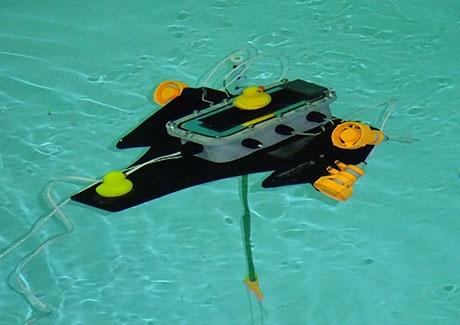
Second-place robot in Junior Division
Our team members are all students of Class C in Year 1. We were able to assemble the robot just fine, but could not get it to move for days on end. Two days before the actual competition, we final achieved movement. On the day of the contest, everyone contributed to our team strategy and the adjustments required on the robot, and we advanced to the finals. There, only one of our motors worked, and we were forced to settle for second place.
During the design process, we learned that we could solve difficult problems using teamwork and the programming skills we had learned at school. Next year, we hope to win the competition by applying new ideas that reduce failures and achieve better control our robot.
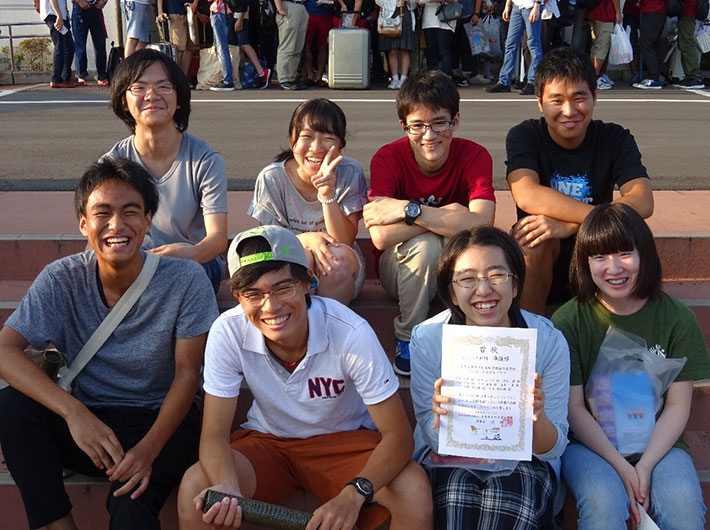
Team Piyopiyo Soul, runners-up in Junior Division
Society for the Study of Robotics
Tokyo Tech's Society for the Study of Robotics, an official student club, focuses on the research and development of robotics, including circuit and software technology. Currently, the club has 184 members, who all have access to a milling machine, lathe, oscilloscope, and other equipment. While many focus on robot creation, club members are free to create whatever they want. The environment is such that even students with no prior knowledge can learn design-related mathematical aspects and circuit-related practical methods from scratch.
. Any information published on this site will be valid in relation to Science Tokyo.








